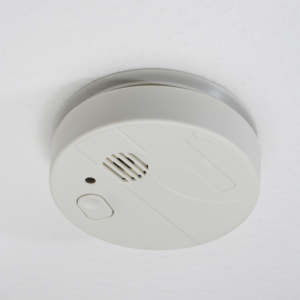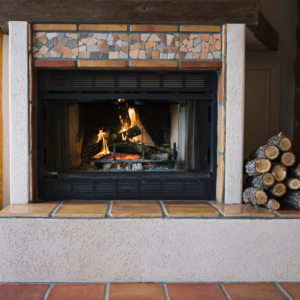At Holy Smoke, Inc., our aim is to bring warmth and security to every home. We know how much you value the space you live in, and we strive to provide you with the services and information you need to use your fireplace as safely as possible. Nothing in life is risk-free, but when you use proper caution, your heating appliance can add warmth and enjoyment to your home without adding extra worry.
First Things First… Schedule an Inspection
Before the first fire of the year your chimney should be professionally inspected by a certified chimney sweep. Investing in regular chimney inspections is an important element of caring for a home fireplace. During a chimney inspection the entire system is evaluated with a keen focus on potential maintenance and safety issues, such as blockages, damage, wear and tear, or creosote build up.
What exactly is creosote? It’s a dark substance that can accumulate in your chimney as a byproduct of the incomplete burning of firewood. It becomes more difficult to remove the longer it stays there, and is dangerous on multiple counts: it’s toxic, it can restrict airflow in your chimney, and it can become a fire hazard.
A chimney should be inspected, swept, and have any issues addressed before you build a fire in the fireplace. Be sure to get in the rhythm of having your chimney inspected every single year before kicking off your burn season.
Test Alarms Routinely
 Smoke alarms and carbon monoxide detectors should have a prominent presence in your home and should be tested regularly. Consider putting it on your calendar and setting a reminder for a set day each month until you’ve established the habit of checking them monthly.
Smoke alarms and carbon monoxide detectors should have a prominent presence in your home and should be tested regularly. Consider putting it on your calendar and setting a reminder for a set day each month until you’ve established the habit of checking them monthly.
If you find they aren’t working, change the batteries immediately. Otherwise change the batteries annually, whether they’re working or not. It’s also wise to keep a fire extinguisher readily at hand in your home.
Keep Your Chimney Clean
You know you don’t want soot, creosote, or debris to be accumulating in your chimney flue, which is why having your chimney swept should always be a priority.
But your fireplace itself also can’t be neglected. A small layer of ash can act as insulation, but you don’t want to let ashes heap up any thicker than one inch in your firebox. Tall ash piles can prevent sufficient air to reach the burning logs, which will lead to a smokier fire. They can also put wear on your fireplace grate, breaking it down prematurely.
Be sure to have your chimney swept frequently, and clear out ashes from your fireplace after your fire has cooled.
Properly Fuel Your Fire
What you put in your fireplace matters and can help minimize soot and creosote buildup. What should go into your fireplace? Well-seasoned firewood – and that’s it. Seasoned firewood is firewood that is sufficiently dried. It has tell-tale signs that it’s ready to use, such as cracks, splits, and darkened edges.
All firewood contains some moisture, but if it contains too much (more than about 25%) it won’t burn very well. This will lead to a smokier fire with cooler flue gases, both of which are undesirable and contribute to creosote build up.
You can help season your firewood by giving wood six or more months after cutting to dry out. If you’re cutting your own firewood this means you need to think ahead – the wood you chop in spring will be ready for autumn fires. Consider cutting wood to shorter lengths and splitting it so there’s more surface exposure to wind and sun. And when storing it, leaving the sides of your woodpile exposed is ideal for seasoning.
What shouldn’t go in your fireplace includes, but isn’t limited to:
 Magazines/newspapers
Magazines/newspapers- Cardboard
- Wrapping or other scrap paper
- Scrap wood from construction
- Plastic
- Christmas trees
- Wet/unseasoned wood
Basically – anything except seasoned firewood!
Burning these things can release toxic chemicals, hot debris capable of traveling up and out of your chimney, or dense, black smoke.
Give It Space
Keep 36-inch of clearance around your fireplace for household decor, furniture, and holiday trinkets. The area surrounding your fireplace can become very hot and cause damage to your decorative items – or even worse, turn them into fire hazards! Consider this when decking the halls for the upcoming holiday season, and give your fireplace the space it needs to receive unobstructed airflow.
And home furnishings and decor aren’t the only things that should be sufficiently spaced three feet away from the fireplace. When you make the appointment to have your fireplace inspected, consider using it as a recurring reminder to give your family a refresher on fireplace safety.
✓ Remind children of how hot a fire burns – and how hot the surrounding area can become – in an age-appropriate way. Little ones may need frequent reminders!
✓ Be sure everyone is aware of the basics: don’t get too close to that inviting flame, don’t leave a fire burning unattended (or be with a fire unattended in the case of young children), and know the plan for what to do if a fire alarm or carbon monoxide detector would go off.
Don’t Wait – Call On Us for Quality Care
Don’t procrastinate on fireplace safety. If you’re looking forward to a cheerfully crackling fire, give us a call at 530-285-3841 to set up your annual inspection and cleaning – or you can reach out to us online. You want your fireplace to be ready when you’re ready to enjoy it!

Recent Comments